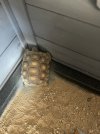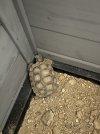ReadyKay
New Member
 Hello, we recently adopted two sulcata tortoises, one is 2 years old with a 3.5” carapace, the second is a 3 year old with with a 4” carapace (measured length wise). We are extremely new to tortoises and are trying to very quickly catch up, we didn’t get them from a great breeder (a family friend who obvs doesn’t know what they’re doing) and are now realizing how much we need to do to make them thrive. We live in between Death Valley and the Sierra Nev Mtns in So. CA.
Hello, we recently adopted two sulcata tortoises, one is 2 years old with a 3.5” carapace, the second is a 3 year old with with a 4” carapace (measured length wise). We are extremely new to tortoises and are trying to very quickly catch up, we didn’t get them from a great breeder (a family friend who obvs doesn’t know what they’re doing) and are now realizing how much we need to do to make them thrive. We live in between Death Valley and the Sierra Nev Mtns in So. CA. Question one - indoor or outdoor enclosure? I’ve been reading posts for 5 hours now and cannot understand if they are large enough to be outside or need to be indoors with outdoors sun time daily.
- if they do need to be indoors, how large should their separate enclosures be? We have space for large indoor enclosures, I’m under the impression that they’re considered juvenile tortoises?
- do they also need to be in a more closed off space that retains humidity at this age?
I’m panicking now because when we got them a month ago, they said they were hibernating. Now I know they’re not (it’s 72 F in their habitat), they’ve slowed down, not opening eyes, not eating. I’m going to fully wake them up and get them hydrated and eating if I can, any tips?. The larger one scratches around a little bit during the day. The smaller one hardly ever moves but is alive.
-They will also be separated today, another horrifying discovery I wish we knew before we got them. *facepalm*
Today I will be creating better enclosures for them, any help is appreciated!
